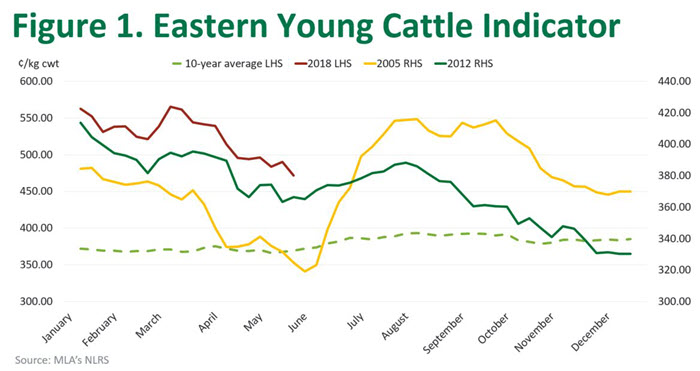To feed, agist or sell depends on your weather outlook
Prepared by Angus Brown, Mecardo, using information from MLA, AuctionsPlus and Farm Tender. Mecardo has previously partnered with MLA Donor Company, utilising non-levy dollars to develop better market analysis for livestock producers.
The dry across southern Australia continues, with little relief in sight. With winter approaching, many cattle producers will be forced into the decision of whether to feed cattle through, sell cattle or put out on agistment in areas which have been lucky enough to score some rain recently.
Today we have a look at how the different strategies compare, and how much cattle might cost to buy back in when it does rain.
Key points
- Coming into winter, decisions need to be made on feeding, agisting or selling cattle in dry areas.
- Feeding and agistment come in at roughly the same cost, with labour and freight being key variables.
- A solid widespread rain will see a good result on carrying young cattle through, but there is risk if further dry weather.
There is a myriad of variables to consider when looking at how or if to carry cattle through the winter. For the purposes of this analysis we’ll look at young heifers which breeders would like to keep as replacements.
Know the numbers
Firstly, we’ll look at the cost of feeding through on a hay ration until September, when hopefully it’s rained and some feed has turned up. So we’re feeding for June, July and August for 90 days. The feed requirement will obviously vary wildly, but we’ll work on the Agriculture Victoria numbers for weaner or yearling cattle, needing 40 MJ ME/day. Around 5.5kg of good quality hay should cover this daily requirement.
If we use the Farm Tender hay prices and add some freight for delivery, we get a price of around $220/tonne for good quality hay. To feed 5.5kg at $220 will cost $1.21/day. To feed for 90 days, the total cost to carry the heifer through will be $109/head.
Agistment rates will vary but some numbers being bandied around are from $6–9/head/week. This equates to $0.85 and $1.28/head/day. It’s a close thing on the actual feed costs, with the decision likely to come down to freight and labour.
Weighing up the costs
For agistment, cattle need to be freighted in and freighted back out at a cost. For feeding, there is a possibly large labour component, which is highly variable depending on the operation.
The cost of feeding heifers, or agisting for three months, will be $100–120 plus labour or freight.
Young heifers are currently making around $650/head on AuctionsPlus, or around 230¢/kg live weight (lwt). We can say that for a producer to be better off holding, rather than selling, prices need to be better than roughly $800/head in September. Otherwise, selling cattle now and buying back will be a better option.
It’s not a great time to be selling store cattle. The restocker spread in the Eastern Young Cattle Indicator (EYCI) hit its weakest level since 2015.
From here, there are two ways the market can go – they’re nicely outlined by price trends in 2005 and 2012 (Figure 1). A widespread heavy rain would see young cattle prices gain ground like in 2005, with the EYCI possibly moving back towards 600¢.

What does it mean/next week?
On the upside, if we take an EYCI of 600¢ and add a bit of basis, store cattle heifers worth $650/head now might be worth 320¢/kg lwt or $960/head in September. This would be a solid profit on the $800/head that heifers would need to be worth after feeding or agistment.
If the season turns out like 2012, we could be looking at store cattle prices around current levels or a little lower in September. This would see money spent on feed or agistment wasted, with another decision to be made in the spring on whether to sell or continue to spend on feed.
MLA resources
MLA offers a full range of tools to help with the dry time decision making process.
Located on this site are calculators which help you establish cost of production, stocking rates, feed demand, rainfall to pasture growth, feed budgets and to support management of animal health and nutrition.
You can also utilise modules and webinars from More Beef from Pastures to plan your way through a dry season.



